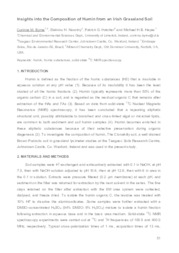Insights into the composition of humin from an irish grassland soil.
Insights into the composition of humin from an irish grassland soil.
Author(s): BYRNE, C. M.; NOVOTNY, E. H.; HATCHER, P. G.; HAYES, M. H. B.
Summary: Humin is defined as the fraction of the humic substances (HS) that is insoluble in aqueous solution at any pH value (1). Because of its insolubility it has been the least studied of all the humic fractions (2). Humin typically represents more than 50% of the organic carbon (C) in a soil, and is regarded as the residual organic C that remains after extraction of the HAs and FAs (3). Based on data from solid-state 13C Nuclear Magnetic Resonance (NMR) spectroscopy, it has been concluded that a repeating aliphatic structural unit, possibly attributable to branched and cross-linked algal or microbial lipids, are common to both sediment and soil humin samples (4). Humin becomes enriched in these aliphatic substances because of their selective preservation during organic diagenesis (2). To investigate the composition of humin, The Clonakilty soil, a well drained Brown Podzolic soil in grassland lysimeter studies at the Teagasc Soils Research Centre, Johnstown Castle, Co. Wexford, Ireland and was used in the present study.
Publication year: 2008
Types of publication: Paper in annals and proceedings
Unit: Embrapa Soils
Keywords: NMR, humic substances, humin, spectroscopy
Observation
Some of Embrapa's publications are published as ePub files. To read them, use or download one of the following free software options to your computer or mobile device. Android: Google Play Books; IOS: iBooks; Windows and Linux: Calibre.
Access other publications
Access the Agricultural Research Database (BDPA) to consult Embrapa's full library collection and records.
Visit Embrapa Bookstore to purchase books and other publications sold by Embrapa.

